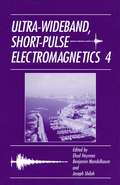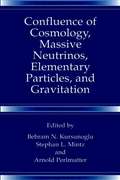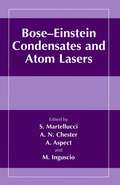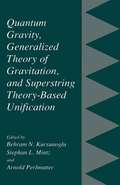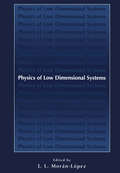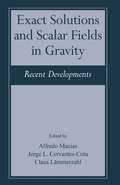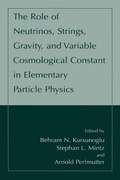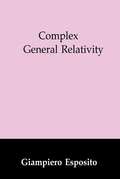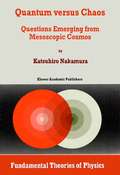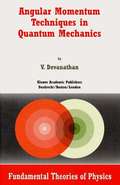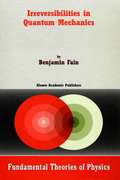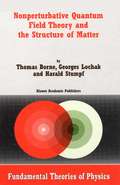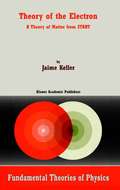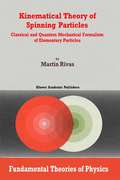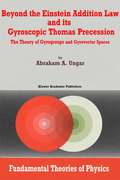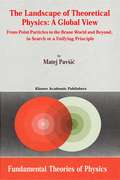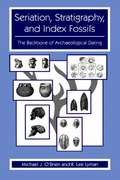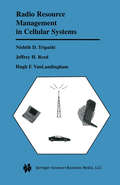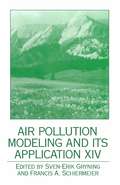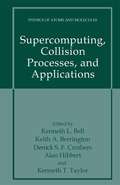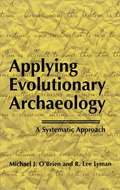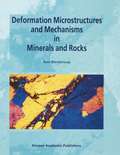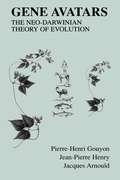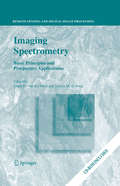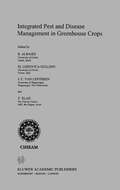- Table View
- List View
Ultra-Wideband Short-Pulse Electromagnetics 4
by Ehud Heyman Benjamin Mandelbaum Joseph ShilohIn the tradition of the previous three conferences, the proceedings of the 4th Ultra-Wideband Short-Pulse Electromagnetics Conference explores topics including pulse generation and detection; broadband electronic systems; antennas - theory, design, experiments and systems; pulse propagation; scattering theory; signal processing; and buried targets - detection and identification.
Confluence of Cosmology, Massive Neutrinos, Elementary Particles, and Gravitation
by Behram N. Kursunogammalu Stephan L. Mintz Arnold PerlmutterJustbefore the preliminary programof Orbis Scientiae 1998 went to press the news in physics was suddenly dominated by the discovery that neutrinos are, after all, massive particles. This was predicted by some physicists including Dr. Behram Kusunoglu, who had apaper published on this subject in 1976 in the Physical Review. Massive neutrinos do not necessarily simplify the physics of elementary particles but they do give elementary particle physics a new direction. If the dark matter content ofthe universe turns out to consist ofneutrinos, the fact that they are massive should make an impact on cosmology. Some of the papers in this volume have attempted to provide answers to these questions. We have a long way to go before we find the real reasons for nature’s creation of neutrinos. Another neutrino-related event was the passing of their discoverer, Fredrick Reines: The trustees of the Global Foundation, members of the Orbis Scientiae 1998, dedicate this conference to Fredrick Reines of the University of California at Irvine. The late Professor Reines was a loyal and active member of these series of conferences on the frontiers of physics and cosmology since 1964. He also sewed as one of the trustees of the Global Foundation for the past three years. Professor Reines discovered the most elusive particle, the neutrino, in 1954. We are proud to say that we recognized the importance of this discovery by awarding him the J.
Bose-Einstein Condensates and Atom Lasers
by S. Martellucci Alain Aspect Arthur N. Chester Massimo InguscioProceedings of the International School of Quantum Electronics 27th course on Bose Einstein Condensates and Atom Lasers, October 19-24, 1999, Erice, Italy. Since the experimental demonstration of Bose Einstein Condensation in dilute atomic gases there has been an explosion of interest in the properties of this novel macroscopic quantum system. The book covers the methods used to produce these new samples of coherent atoms, their manipulation and the study of their properties. Emphasis is given to the anticipated development of new types of sources, which more and more resemble traditional types of lasers. Because of recent new applications and increasing demand for lasers, sensors and associated instrumentation, the chapters also cover current developments in the basic techniques, materials and applications in the field of the generation of coherent atoms.
Quantum Gravity, Generalized Theory of Gravitation, and Superstring Theory-Based Unification
by Behram N. Kursunogammalu Stephan L. Mintz Arnold PerlmutterPhysics of Low Dimensional Systems
by J. L. Morán-LópezOaxaca, Mexico, was the place chosen by a large international group of scientists to meet and discuss on the recent advances on the understanding of the physical prop- ties of low dimensional systems; one of the most active fields of research in condensed matter in the last years. The International Symposium on the Physics of Low Dim- sions took place in January 16-20, 2000. The group of scientists converging into the historical city of Oaxaca, in the state of the same name, had come from Argentina, Chile, Venezuela, several places in Mexico, Canada, U. S. A. , England, France, Italy, Germany, Russia, and Switzerland. The presentations at the workshop provided sta- of-art reviews of many of the most important problems, currently under study. Equally important to all the participants in the workshop was the fact that we had come to honor a friend, Hans Christoph Siegmann, on his sixty-fifth birthday. This Festschrift recognizes the intellectual leadership of Professor Siegmann in the field and as a sincere homage to his qualities as an exceptional friend, college and mentor. Those who have had the privilege to work closely with Hans Christoph have been deeply impressed by his remarkable analytic mind as well as by his out of range kindness and generosity. Hans Christoph has contributed to the understanding of the difficult and very important problem of the magnetic properties of finite systems: surfaces, thin films, heterostructures.
Exact Solutions and Scalar Fields in Gravity: Recent Developments
by Alfredo Macías Jorge L. Cervantes-Cota Claus LämmerzahlDivided into four parts, this book covers recent developments in topics pertaining to gravity theories, including discussions on the presence of scalar fields. Part One is devoted to exact solutions in general relativity, and is mainly concerned with the results of rotating null dust beams and fluids. Also included is a panoramic vision of new research directions in this area, which would require revising certain theorems and their possible extensions within gravity theories, new aspects concerning the Ernst potentials, double Kerr spacetimes, and rotating configurations. In particular, there is a detailed discussion of totally symmetric and totally geodesic spaces, in which a method for generating (2+1)-dimensional solutions from (3+1)-dimensional solutions is given. Part Two deals with alternative theories of gravity, all of which include scalar fields and gauge fields. Here, quantum and cosmological effects, which arise from both gravity theories in four and higher dimensions and from metric-affine theories, are investigated. Part Three is devoted to cosmological and inflationary scenarios. Local effects, such as the influence of scalar fields in protogalactic interactions, numerical studies of the collapse of molecular cores, as well as the inverse inflationary problem and the blue eigenvalue spectrum of it, are considered. Moreover, the role of scalar fields as dark matter and quantum cosmology in the Bergman-Wagoner and Gowdy theories, together with the relation of the conformal symmetry and deflationary gas universe, are likewise presented. The last part of the book includes some mixed topics which are still in the experimental stage. Among them are the foundation of the Maxwell theory, a discussion on electromagnetic Thirring problems, a note on the staticity of black holes with non-minimally coupled scalar fields, and a study of the Lorentz force free charged fluids in general relativity. Thus, this book is the most up-to-date, comprehensive collection of papers on the subject of exact solutions and scalar fields in gravity and is a valuable tool for researchers in the area.
The Role of Neutrinos, Strings, Gravity, and Variable Cosmological Constant in Elementary Particle Physics
by Stephan L. Mintz Arnold Perlmutter Behram N. Kursunogammaluth The 29 International Conference was held as the first one of the millennium at its Fort Lauderdale venue. These conferences began, with High Energy Physics being the main topic, by introducing gradually cosmology into its programs. These proceedings of the 2000 conference reflect the variety of topics and ideas discussed. Our future conferences will be designed somewhat akin to the early Coral Gables Conferences where we shall seek some convergence of ideas. For this reason various committees have been formed from among the participating physicists. The committees and their memberships are listed in these proceedings. We further decided for the first time to include some graduate student participants in our future meetings for which also a committee has already been established. The topics will demonstrate a more activist structure of the Coral Gables Conferences, for example the duality of the gravitational forces and expansion of the universe will be discussed from this point of view since it conveys a convergence to the ideas of quintessence versus the ordinary theory, which are considered as the cause of the expansion of the universe. We further wish to announce that the future conferences will assume a collective organization where several committees as listed in these proceedings will have their input into the conference. We have now introduced new topics and ideas, which referred especially to the attractive and repulsive nature of the gravitational force. These proceedings of the conference contain a variety of topics and ideas.
Complex General Relativity (Fundamental Theories of Physics #69)
by Giampiero EspositoThis book is written for theoretical and mathematical physicists and mat- maticians interested in recent developments in complex general relativity and their application to classical and quantum gravity. Calculations are presented by paying attention to those details normally omitted in research papers, for pedagogical r- sons. Familiarity with fibre-bundle theory is certainly helpful, but in many cases I only rely on two-spinor calculus and conformally invariant concepts in gravitational physics. The key concepts the book is devoted to are complex manifolds, spinor techniques, conformal gravity, ?-planes, ?-surfaces, Penrose transform, complex 3 1 – – space-time models with non-vanishing torsion, spin- fields and spin- potentials. 2 2 Problems have been inserted at the end, to help the reader to check his und- standing of these topics. Thus, I can find at least four reasons for writing yet another book on spinor and twistor methods in general relativity: (i) to write a textbook useful to - ginning graduate students and research workers, where two-component spinor c- culus is the unifying mathematical language.
Quantum versus Chaos: Questions Emerging from Mesoscopic Cosmos (Fundamental Theories of Physics #87)
by K. NakamuraQuantum and chaos, key concepts in contemporary science, are incompatible by nature. This volume presents an investigation into quantum transport in mesoscopic or nanoscale systems which are classically chaotic and shows the success and failure of quantal, semiclassical, and random matrix theories in dealing with questions emerging from the mesoscopic cosmos. These traditional theories are critically analysed, and this leads to a new direction. To reconcile quantum with chaos and to restore genuine temporal chaos in quantum systems, a time-discrete variant of quantum dynamics is proposed. Audience:This book will be of interest to graduate students and researchers in physics, chemistry and mathematics, whose work involves fundamental questions of quantum mechanics in chaotic systems.
Angular Momentum Techniques in Quantum Mechanics (Fundamental Theories of Physics #108)
by V. DevanathanA course in angular momentum techniques is essential for quantitative study of problems in atomic physics, molecular physics, nuclear physics and solid state physics. This book has grown out of such a course given to the students of the M. Sc. and M. Phil. degree courses at the University of Madras. An elementary knowledge of quantum mechanics is an essential pre-requisite to undertake this course but no knowledge of group theory is assumed on the part of the readers. Although the subject matter has group-theoretic origin, special efforts have been made to avoid the gro- theoretical language but place emphasis on the algebraic formalism dev- oped by Racah (1942a, 1942b, 1943, 1951). How far I am successful in this project is left to the discerning reader to judge. After the publication of the two classic books, one by Rose and the other by Edmonds on this subject in the year 1957, the application of angular momentum techniques to solve physical problems has become so common that it is found desirable to organize a separate course on this subject to the students of physics. It is to cater to the needs of such students and research workers that this book is written. A large number of questions and problems given at the end of each chapter will enable the reader to have a clearer understanding of the subject.
Irreversibilities in Quantum Mechanics (Fundamental Theories of Physics #113)
by B. FainThe problem of irreversibility is ubiquitous in physics and chemistry. The present book attempts to present a unified theoretical and conceptual framework for the description of various irreversible phenomena in quantum mechanics. In a sense, this book supplements conventional textbooks on quantum mechanics by including the theory of irreversibilities. However, the content and style of this book are more appropriate for a monograph than a textbook. We have tried to arrange the material so that, as far as possible, the reader need not continually refer elsewhere. The references to the literature make no pretense of completeness. The book is by no means a survey of present theoretical work. We have tried to highlight the basic principles and their results, while the attention has been mainly paid to the problems in which the author himself has been involved. The book as a whole is designed for the reader with knowledge of theoretical physics (especially quantum mechanics) at university level. This book is based on the courses of lectures given at the Chemistry Department of Tel-Aviv University.
Nonperturbative Quantum Field Theory and the Structure of Matter (Fundamental Theories of Physics #114)
by T. Borne G. Lochak H. StumpfTheory of the Electron: A Theory of Matter from START (Fundamental Theories of Physics #115)
by J. KellerIn the first century after its discovery, the electron has come to be a fundamental element in the analysis of physical aspects of nature. This book is devoted to the construction of a deductive theory of the electron, starting from first principles and using a simple mathematical tool, geometric analysis. Its purpose is to present a comprehensive theory of the electron to the point where a connection can be made with the main approaches to the study of the electron in physics. The introduction describes the methodology. Chapter 2 presents the concept of space-time-action relativity theory and in chapter 3 the mathematical structures describing action are analyzed. Chapters 4, 5, and 6 deal with the theory of the electron in a series of aspects where the geometrical analysis is more relevant. Finally in chapter 7 the form of geometrical analysis used in the book is presented to elucidate the broad range of topics which are covered and the range of mathematical structures which are implicitly or explicitly included. The book is directed to two different audiences of graduate students and research scientists: primarily to theoretical physicists in the field of electron physics as well as those in the more general field of quantum mechanics, elementary particle physics, and general relativity; secondly, to mathematicians in the field of geometric analysis.
Kinematical Theory of Spinning Particles: Classical and Quantum Mechanical Formalism of Elementary Particles (Fundamental Theories of Physics #116)
by M. RivasClassical spin is described in terms of velocities and acceleration so that knowledge of advanced mathematics is not required. Written in the three-dimensional notation of vector calculus, it can be followed by undergraduate physics students, although some notions of Lagrangian dynamics and group theory are required. It is intended as a general course at a postgraduate level for all-purpose physicists. This book presents a unified approach to classical and quantum mechanics of spinning particles, with symmetry principles as the starting point. A classical concept of an elementary particle is presented. The variational statements to deal with spinning particles are revisited. It is shown that, by explicitly constructing different models, symmetry principles are sufficient for the description of either classical or quantum-mechanical elementary particles. Several spin effects are analyzed.
Beyond the Einstein Addition Law and its Gyroscopic Thomas Precession: The Theory of Gyrogroups and Gyrovector Spaces (Fundamental Theories of Physics #117)
by A.A. UngarEvidence that Einstein's addition is regulated by the Thomas precession has come to light, turning the notorious Thomas precession, previously considered the ugly duckling of special relativity theory, into the beautiful swan of gyrogroup and gyrovector space theory, where it has been extended by abstraction into an automorphism generator, called the Thomas gyration. The Thomas gyration, in turn, allows the introduction of vectors into hyperbolic geometry, where they are called gyrovectors, in such a way that Einstein's velocity additions turns out to be a gyrovector addition. Einstein's addition thus becomes a gyrocommutative, gyroassociative gyrogroup operation in the same way that ordinary vector addition is a commutative, associative group operation. Some gyrogroups of gyrovectors admit scalar multiplication, giving rise to gyrovector spaces in the same way that some groups of vectors that admit scalar multiplication give rise to vector spaces. Furthermore, gyrovector spaces form the setting for hyperbolic geometry in the same way that vector spaces form the setting for Euclidean geometry. In particular, the gyrovector space with gyrovector addition given by Einstein's (Möbius') addition forms the setting for the Beltrami (Poincaré) ball model of hyperbolic geometry. The gyrogroup-theoretic techniques developed in this book for use in relativity physics and in hyperbolic geometry allow one to solve old and new important problems in relativity physics. A case in point is Einstein's 1905 view of the Lorentz length contraction, which was contradicted in 1959 by Penrose, Terrell and others. The application of gyrogroup-theoretic techniques clearly tilt the balance in favor of Einstein.
The Landscape of Theoretical Physics: From Point Particles to the Brane World and Beyond in Search of a Unifying Principle (Fundamental Theories of Physics #119)
by M. PavsicToday many important directions of research are being pursued more or less independently of each other. These are, for instance, strings and mem branes, induced gravity, embedding of spacetime into a higher dimensional space, the brane world scenario, the quantum theory in curved spaces, Fock Schwinger proper time formalism, parametrized relativistic quantum the ory, quantum gravity, wormholes and the problem of “time machines”, spin and supersymmetry, geometric calculus based on Clifford algebra, various interpretations of quantum mechanics including the Everett interpretation, and the recent important approach known as “decoherence”. A big problem, as I see it, is that various people thoroughly investigate their narrow field without being aware of certain very close relations to other fields of research. What we need now is not only to see the trees but also the forest. In the present book I intend to do just that: to carry out a first approximation to a synthesis of the related fundamental theories of physics. I sincerely hope that such a book will be useful to physicists. From a certain viewpoint the book could be considered as a course in the oretical physics in which the foundations of all those relevant fundamental theories and concepts are attempted to be thoroughly reviewed. Unsolved problems and paradoxes are pointed out. I show that most of those ap proaches have a common basis in the theory of unconstrained membranes. The very interesting and important concept of membrane space, the tensor calculus in and functional transformations in are discussed.
Seriation, Stratigraphy, and Index Fossils: The Backbone of Archaeological Dating
by Michael J. O'Brien R. Lee LymanIt is difficult for today's students of archaeology to imagine an era when chronometric dating methods were unavailable. However, even a casual perusal of the large body of literature that arose during the first half of the twentieth century reveals a battery of clever methods used to determine the relative ages of archaeological phenomena, often with considerable precision. Stratigraphic excavation is perhaps the best known of the various relative-dating methods used by prehistorians. Although there are several techniques of using artifacts from superposed strata to measure time, these are rarely if ever differentiated. Rather, common practice is to categorize them under the heading `stratigraphic excavation'. This text distinguishes among the several techniques and argues that stratigraphic excavation tends to result in discontinuous measures of time - a point little appreciated by modern archaeologists. Although not as well known as stratigraphic excavation, two other methods of relative dating have figured important in Americanist archaeology: seriation and the use of index fossils. The latter (like stratigraphic excavation) measures time discontinuously, while the former - in various guises - measures time continuously. Perhaps no other method used in archaeology is as misunderstood as seriation, and the authors provide detailed descriptions and examples of each of its three different techniques. Each method and technique of relative dating is placed in historical perspective, with particular focus on developments in North America, an approach that allows a more complete understanding of the methods described, both in terms of analytical technique and disciplinary history. This text will appeal to all archaeologists, from graduate students to seasoned professionals, who want to learn more about the backbone of archaeological dating.
Radio Resource Management in Cellular Systems (The Springer International Series in Engineering and Computer Science #618)
by Nishith D. Tripathi Jeffrey H. Reed Hugh F. VanLandinghamRadio Resource Management in Cellular Systems is the first book to address the critical issue of radio resource management in emerging (i.e., third generation and beyond) wireless systems. This book presents novel approaches for the design of high performance handoff algorithms that exploit attractive features of several existing algorithms, provide adaptation to dynamic cellular environment, and allow systematic tradeoffs among different system characteristics. Efficient handoff algorithms cost-effectively enhance the capacity and quality of service (QoS) of cellular systems. A comprehensive foundation of handoff and related issues of cellular communications is given. Tutorial-type material on the general features of 3G and 3.5G wireless systems (including CDMA2000, UMTS, and 1xEV-DO) is provided. Key elements for the development of simulators to study handoff and overall RF performance of the integrated voice and data cellular systems (including those based on CDMA) are also described. Finally, the powerful design tools of neural networks and fuzzy logic are applied to wireless communications, so that the generic algorithm approaches proposed in the book can be applied to many other design and development areas. The simulation models described in the book represent a single source that provides information for the performance evaluation of systems from handoff and resource management perspectives. Radio Resource Management in Cellular Systems will prove a valuable resource for system designers and practicing engineers working on design and development of third generation (and beyond) wireless systems. It may also be used as a text for advanced-level courses in wireless communications and neural networks.
Air Pollution Modeling and its Application XIV
by Sven-Erik Gryning Francis A. SchiermeierProceedings of the Millennium NATO/CCMS International Technical Meeting on Air Pollution Modeling and its Application, held May 15-19 in Boulder, Colorado. This volume is the latest in a series of proceedings dating back to 1971. The book addresses the problem of air pollution and reports the latest findings and developments in air pollution modeling, from a truly international list of contributors.
Supercomputing, Collision Processes, and Applications (Physics of Atoms and Molecules)
by Kenneth L. Bell Derrick S. F. Crothers Alan Hibbert Kenneth T. Taylor Keith A. BerringtonProfessor Philip G. Burke, CBE, FRS formally retired on 30 September 1998. To recognise this occasion some of his colleagues, friends, and former students decided to hold a conference in his honour and to present this volume as a dedication to his enormous contribution to the theoretical atomic physics community. The conference and this volume of the invited talks reflect very closely those areas with which he has mostly been asso- ated and his influence internationally on the development of atomic physics coupled with a parallel growth in supercomputing. Phil’s wide range of interests include electron-atom/molecule collisions, scattering of photons and electrons by molecules adsorbed on surfaces, collisions involving oriented and chiral molecules, and the development of non-perturbative methods for studying multiphoton processes. His devel- ment of the theory associated with such processes has enabled important advances to be made in our understanding of the associated physics, the interpretation of experimental data, has been invaluable in application to fusion processes, and the study of astrophysical plasmas (observed by both ground- and space-based telescopes). We therefore offer this volume as our token of affection and respect to Philip G. Burke, with the hope that it may also fill a gap in the literature in these important fields.
Applying Evolutionary Archaeology: A Systematic Approach
by Michael J. O'Brien R. Lee LymanAnthropology, and by extension archaeology, has had a long-standing interest in evolution in one or several of its various guises. Pick up any lengthy treatise on humankind written in the last quarter of the nineteenth century and the chances are good that the word evolution will appear somewhere in the text. If for some reason the word itself is absent, the odds are excellent that at least the concept of change over time will have a central role in the discussion. After one of the preeminent (and often vilified) social scientists of the nineteenth century, Herbert Spencer, popularized the term in the 1850s, evolution became more or less a household word, usually being used synonymously with change, albeit change over extended periods of time. Later, through the writings of Edward Burnett Tylor, Lewis Henry Morgan, and others, the notion of evolution as it applies to stages of social and political development assumed a prominent position in anthropological disc- sions. To those with only a passing knowledge of American anthropology, it often appears that evolutionism in the early twentieth century went into a decline at the hands of Franz Boas and those of similar outlook, often termed particularists. However, it was not evolutionism that was under attack but rather comparativism— an approach that used the ethnographic present as a key to understanding how and why past peoples lived the way they did (Boas 1896).
Deformation Microstructures and Mechanisms in Minerals and Rocks
by Tom G. BlenkinsopThis book is a systematic guide to the recognition and interpretation of deformation microstructures and mechanisms in minerals and rocks at the scale of a thin section. Diagnostic features of microstructures and mechanisms are emphasized, and the subject is extensively illustrated with high-quality color and black and white photomicrographs, and many clear diagrams. After introducing three main classes of deformation microstructures and mechanisms, low- to high-grade deformation is presented in a logical sequence in Chapters 2 to 5. Magmatic/submagmatic deformation, shear sense indicators, and shock microstructures and metamorphism are described in Chapters 6 to 8, which are innovative chapters in a structural geology textbook. The final chapter shows how deformation microstructures and mechanisms can be used quantitatively to understand the behavior of the earth. Recent experimental research on failure criteria, frictional sliding laws, and flow laws is summarized in tables, and palaeopiezometry is discussed. Audience: This book is essential to all practising structural and tectonic geologists who use thin sections, and is an invaluable research tool for advanced undergraduates, postgraduates, lecturers and researchers in structural geology and tectonics.
Gene Avatars: The Neo-Darwinian Theory of Evolution
by Pierre-Henri Gouyon Jean-Pierre Henry Jacques Arnould`Why life?' Questions of this type were for a long time the prerogative of philosophers who left the `how' question to scientists. Nowadays, Darwin's successors no longer have any qualms about addressing the `why' as well as the `how'. Over a century ago, Darwin modestly admitted having 'thrown some light on the origin of species - this mystery of mysteries'. Two major advances in the following decades helped biologists answer many of the questions he left unsolved. The first was the discovery of the laws of heredity, the second that of DNA. Both provided Darwinian theory with the foundations that were lacking and led to the all-embracing neo-Darwinian synthesis. Since then, Theodosius Dobzhansky's aphorism `nothing in biology makes sense except in the light of evolution' has proven true more than once. This does not suit everyone, as evolutionist ideas have not lost their power to cause a scandal. Darwin toppled man from his pedestal. Evolutionary genetics - the subject of this book - sends the individual crashing. Considered until recently to be the target of selection and the focus of evolution, the individual has been usurped by the gene. The individual is nothing but the gene's avatar.
Imaging Spectrometry: Basic Principles and Prospective Applications (Remote Sensing and Digital Image Processing #4)
by Freek D. Van Der Meer S. M. De JongA significant step forward in the world of earth observation was made with the development of imaging spectrometry. Imaging spectrometers measure reflected solar radiance from the earth in many narrow spectral bands. Such a spectroscopical imaging system is capable of detecting subtle absorption bands in the reflectance spectra and measure the reflectance spectra of various objects with a very high accuracy. As a result, imaging spectrometry enables a better identification of objects at the earth surface and a better quantification of the object properties than can be achieved by traditional earth observation sensors such as Landsat TM and SPOT. The various chapters in the book present the concepts of imaging spectrometry by discussing the underlying physics and the analytical image processing techniques. The second part of the book presents in detail a wide variety of applications of these new techniques ranging from mineral identification, mapping of expansive soils, land degradation, agricultural crops, natural vegetation and surface water quality. Additional information on extras.springer.comSample hyperspectral remote sensing data sets and ENVI viewing software (Freelook) are available on http://extras.springer.com
Integrated Pest and Disease Management in Greenhouse Crops (Developments in Plant Pathology #14)
by Ramon Albajes Yigal Elad M. Lodovica Gullino J. C. Van LenterenThe International Centre for Advanced Mediterranean Agronomic Studies (CIHEAM), established in 1962, is an intergovernmental organization of 13 countries: Albania, Algeria, Egypt, France, Greece, Italy, Lebanon, Malta, Morocco, Portugal, Spain, Tunisia and Turkey. Four institutes (Bari, Italy; Chania, Greece; Montpellier, France; and Zaragoza, Spain) provide postgraduate education at the Master of Science level. CIHEAM promotes research networks on Mediterranean agricultural priorities, supports the organization of specialized education in member countries, holds seminars and workshops bringing together technologists and scientists involved in Mediterranean agriculture and regularly produces diverse publications including the series Options Méditerranéennes. Through these activities, CIHEAM promotes North/South dialogue and international co-operation for agricultural development in the Mediterranean region. Over the past decade, the Mediterranean Agronomic Institute of Zaragoza has developed a number of training and research-supporting activities in the field of agroecology and sustainability of agricultural production systems. Some of these activities have been concerned with the rational use of pesticides and more particularly with the implementation of integrated control systems in order to gain in efficacy and decrease both the environmental impact and the negative repercussions for the commercialization of agricultural products.
